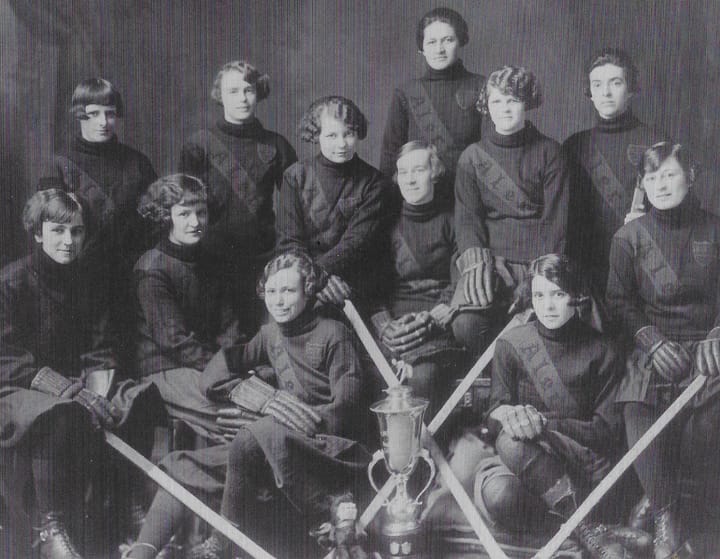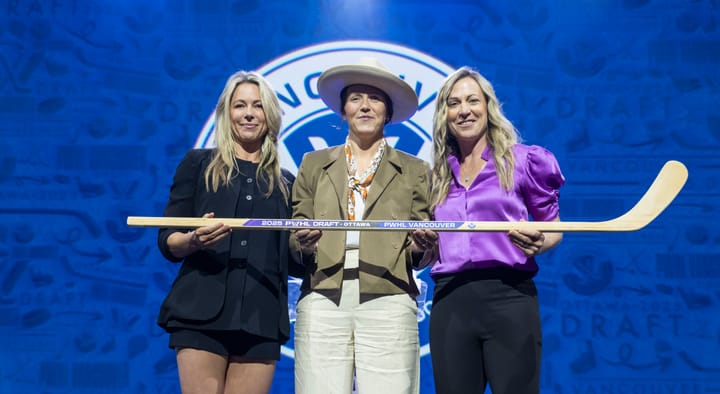The prevalence and growth of women’s hockey across the globe
Quantifying where the women’s game is most present and most changing
If you’re reading this story you’ve likely read and heard the claim that women’s (and girls’) hockey is one of the fastest growing sports in the world.
According to the IIHF, the number of registered female players has grown 33.85 percent between 2007 and 2018. Today, there are 209,966 registered female players across the 81 nations with IIHF memberships and 208,054 players in the 40 women’s national teams ranked by the federation. However, 81.69 percent (171,540) of those players are in the U.S. and Canada.
So, just how prevalent and popular is women’s hockey outside of North America?
Note: when looking at the IIHF’s player registration data it’s important to note that it excludes players who aren’t registered and “junior player” data. As a result, these numbers only offer a limited view of the women’s hockey landscape across the globe. Furthermore, this data appears to be limited to a binary definition of gender — The Ice Garden has reached out to the IIHF for clarification on this issue.
Those interested in the data used in this article can find it on this public Google Sheet.
History
Women’s hockey is considered a newer sport in much of the world, including much of Europe. It should come as no surprise that the country with the longest history and deepest roots in the game is Canada.
Significant historical events, including the Great Depression, derailed the sport’s momentum in North America until it appeared to regain its footing in the 1960s. But it’s clear that the women’s game caught on west of the Atlantic Ocean before it did on the other side of the pond. In 1995, the Canadian Hockey Association (CHA) reported 19,050 registered female players [On the Edge: Women Making Hockey History, 1996]. That’s more than Sweden, Finland, the Czech Republic, and Switzerland have combined today.
Sweden’s first organized women’s game — Timrå IK vs MODO AIK — took place in 1969. The SDHL wasn’t established until 2007; Finland’s Naisten Liiga (then called Naisten SM-Sarja) was founded in 1982. Seven years after pro women’s hockey was established in Finland, the IIHF organized the first European Women Championship. The inaugural IIHF Women’s World Championship in 1990 was a watershed moment for the sport that was later overshadowed by the debut of women’s ice hockey at the 1998 Winter Olympics in Nagano, Japan.
The Data
Most North American hockey fans are familiar with the popularity of men’s hockey in Europe and Russia. That rising popularity has been reflected in the swelling ranks of Europeans in the NHL over the last 40 years. In 1980, 82.2 percent of NHL players were Canadian and 4.2 were European; in 2017, 45.9 percent were Canadian and 28.1 percent were European or Russian.
One might assume that there would be a correlation between the popularity of men’s hockey and women’s hockey in prominent European hockey powers, but that is not necessarily the case.
Registered female players account for 45.9 percent of all U20 registrations in Canada; in the United States, that number is 33.74 percent*. That’s a substantial gap, but not an altogether surprising one considering the popularity of the game north of the border. In Russia, registered female players account for 13.42 percent of registrations; in Finland, it’s 13.15 percent; in Sweden, it’s 29.86 percent; in the Czech Republic, it’s 3.92 percent. The ratios are a bit all over the map.
The gaps in the ratios of registered male and female hockey players in any nation goes far beyond different levels of interest. The prevalence of girls’ and women’s hockey in any nation is influenced by a multitude of factors, including climate and socioeconomic and cultural issues like sexism. The majority of these factors — including sexism — are difficult to quantify, but we can look for their fingerprints by identifying countries with lackluster track records in human rights, workplace inequality, imbalances in access to education and institutions based on gender and/or race, and low visibility of women’s sport. Remember, no country gets full marks here. Women’s sports, including hockey, are underserved across the globe.
Still, we can use the IIHF’s data to give us a snapshot of the prevalence of the women’s game across the globe.
One of the biggest questions relating to the prevalence of women’s hockey is about accessibility. According to the IIHF, Canada has 3,300 indoor rinks and 5,000 outdoor rinks, whereas there are just 19 rinks (16 indoor, 3 outdoor) in Latvia. It stands to reason that girls and women would be more likely to get involved with hockey if they have access to an ice surface. So; more rinks, more women’s hockey? Well, kinda.
The interactive table above shows each IIHF member nation’s number of indoor rinks and a percentage that represents the number of registered female players divided by the total population of each nation. Again, this methodology is far from ideal, but it serves as a rough indication of the popularity/prevalence of women’s hockey in each nation.
The quantity of rinks has something to do with the prevalence of women’s hockey in these countries, but it’s clearly not the only factor.
Growth across the Globe
The IIHF doesn’t have a public archive of registration data, but, fortunately, I was able to find the data published in an SB Nation article from 2013. The growth of hockey, particularly women’s hockey, in Asia has made a lot of headlines in recent years and the data visualized in the chart below definitely tells that story.
It shouldn’t come as much of a surprise that the growth in registered female players has plateaued in Canada (1.72% growth) and Finland (-7.37% growth). Canada and Finland are first and second, respectively, in registered female players per capita. However, the big story here is the explosion of registered female players in Russia, China, and the Ukraine.
Although Russia still has a low number of registered female players per capita (0.00186) relative to the U.S. and Canada, the women’s game is exploding there. Part of this growth is evidenced by the ZhHL (Russian Women’s Hockey League), which was reorganized in 2015 following a collaboration between the KHL (Kontinental Hockey League) and the Ice Hockey Federation of Russia.
The growth of the game in China is also directly tied to a recent infusion of resources. The Chinese government and businessman Billy Ngok have invested heavily in women’s hockey in the hopes of improving the national team and building the sport within China’s borders before the 2022 Olympics in Beijing. Ngok’s investment resulted in the creation of two Chinese CWHL teams in 2017, which has since become a single team based in Shenzhen in the ZhHL. This year, the KRS Vanke Rays were champions of the ZhHL.
Ukraine’s growth is also a story unto itself. Ukraine competed in its first IIHF Women’s World Championship in 2019 as a direct result of the creation of the Ukrainian Women’s Hockey Championship in 2017. The competition was created by three women — Olexandra Slatvytska, Nadia Boboshko, and Yulia Artemyeva — who have dedicated themselves to growing the game in their home country.
Trends and Takeaways
Clearly, even a little context can go a long way with some of the data we’ve been looking at. Here are several more notes, trends, and takeaways to consider in this snapshot of women’s hockey across the globe in 2020.
- Among the 40 nations with an IIHF ranked women’s national team, female registrations account for 29.83 percent of senior players. Among the IIHF’s 41 other member nations, that percentage drops to 21.14.
- Several countries that are new to the international hockey scene have more female registrations than male. Noteworthy among that group are Iceland (1992), Kuwait (2009), Lebanon (2019), and Turkey (1991). However, there are exceptions, including Singapore (1996), Kazakhstan (1992), and the United Arab Emirates (2001).
- Iceland is likely the most women’s hockey-loving small country in the world. It has a population under 350,000 — which is roughly the population of Anaheim, California — and just three indoor rinks, but its ranked 31st among women’s national teams. Only Canada, Sweden, and Finland have a higher percentage of registered female players per capita.
- The Czech Republic has the lowest ratio of female registrations (3.96%) among countries with women’s national teams currently ranked inside of the IIHF’s top-10. The lack of registered female players (3,740) relative to male players (90,610) in the Czech Republic calls for further research, but those numbers are swelling.
- Latvia (1.42%) has the lowest ratio of female registrations of any country with an IIHF ranked women’s national team. There are just 74 registered female players in Latvia, down from 82 in 2013.
- Denmark’s women’s national team has a lot of talent for a country with 702 registered players. The Danes are currently ranked 11th in the world by the IIHF after finishing second at the 2019 Division I Worlds.
- Sweden’s recent struggles in major international tournaments have been well-documented, but women’s hockey is still growing strong there despite its already strong presence. The percentage of female registrations in Sweden (29.86%) are similar to those in the United States (33.74%) and in Germany (30.85%).
- The growth of registered female players has begun to plateau for Canada, but that is not the case in the United States. In 2013, there were 65, 700 registered female players. That number has swollen to 82,808 in 2020 — that’s a 26.04 percent increase. The growth in male registrations in that same time frame is 18.06 percent./
All data courtesy of IIHF.com unless otherwise stated.
*= Editor’s note [Updated 11/8/2021]: Data and visualization from this article should not be used or cited until the story is updated again. It has been brought to the author’s attention that the IIHF only differentiates between male and female registrants for the U20 levels.





Comments ()